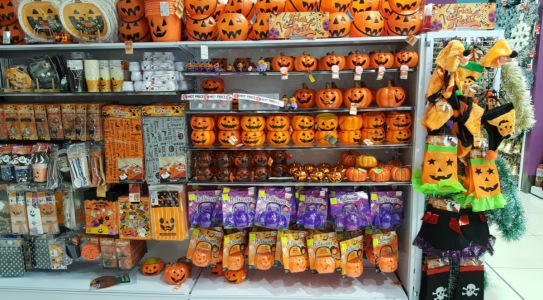Investigation reveals half of online Halloween purchases may endanger kids
By
Gian T
- Replies 12
The excitement for Halloween is palpable as the jack-o'-lanterns appear and the spooky decorations adorn Australian homes.
But before you click 'add to cart' on that seemingly perfect costume or those eerie decorations from an online retailer, there's a chilling warning you should heed.
A recent investigation by Western Australia's Consumer Protection Agency has revealed a frightening fact: half of the Halloween items purchased online may violate Australia's stringent product safety laws.
The agency's experiment involved purchasing 12 products from a well-known online retailer and found that about half needed to meet safety standards.
Among the hazardous finds were items containing dangerous button batteries, highly flammable clothing, and cosmetic products lacking proper ingredient listings, which could lead to severe allergic reactions without the ability to identify the cause quickly.
The retailer's name remains undisclosed as the investigation is ongoing, and legal action is possible.
However, Consumer Protection Commissioner Trish Blake's message is clear: vigilance is key, especially when it comes to the safety of our children during the Halloween festivities.
If ingested by a curious child, the consequences can be dire, leading to severe internal burns, perforation of the esophagus, and, in the worst cases, death.
Ms Blake urged parents and caregivers to thoroughly investigate the source of their Halloween purchases, primarily online, as products may originate from countries with less stringent regulations.
Ena Vejnovic, a PhD in marketing at the University of Western Australia, attributes this surge to social media's influence and the pervasiveness of US pop culture.
‘I think Halloween is bigger than ever here in Australia, especially in the last two years,’ she said.
‘Mainly because of our accessibility to the internet and the prominence of pop culture here in Australia.’
‘We have things like TikTok and Instagram that are so easily accessible, and all these American brands and organisations are targeting content towards us [so] we're more likely to become part of this kind of trend.’
‘A lot of what we consume—influencers, movies, TV—pretty much comes from the US, so when we see these things and the way they celebrate Halloween and take part in it, we have such easy access to it.’
‘We can also purchase things online from the US, so if we're consuming things off those other websites as well, we're more prone to adopting these activities and Halloween-related products.’
James Hall, a lecturer in media, communications, and popular culture at Edith Cowan University, echoes this sentiment, predicting that the commercialisation of Halloween in Australia will continue to grow.
‘If it makes money, people will continue to do it,’ he said.
‘We see it with Christmas, we see it with Easter, Valentine's Day. All of these holidays are a good opportunity to sell 'shifty units’.
‘If that continues to work, nobody has a good reason to stop doing it.’
Despite the convenience of online shopping, the investigation suggested that traditional in-store purchases may be the safer bet.
‘We also did some in-store inspections, and the news there is much better,’ Blake said.
‘Our staff looked at 192 products and found that only two were non-compliant.’
‘So the in-store retailers, the bricks and mortar shops, are doing a much better job.’

Have you had any spooky experiences with online Halloween shopping? Share your stories and tips for a safe celebration in the comments below.
But before you click 'add to cart' on that seemingly perfect costume or those eerie decorations from an online retailer, there's a chilling warning you should heed.
A recent investigation by Western Australia's Consumer Protection Agency has revealed a frightening fact: half of the Halloween items purchased online may violate Australia's stringent product safety laws.
The agency's experiment involved purchasing 12 products from a well-known online retailer and found that about half needed to meet safety standards.
Among the hazardous finds were items containing dangerous button batteries, highly flammable clothing, and cosmetic products lacking proper ingredient listings, which could lead to severe allergic reactions without the ability to identify the cause quickly.
The retailer's name remains undisclosed as the investigation is ongoing, and legal action is possible.
However, Consumer Protection Commissioner Trish Blake's message is clear: vigilance is key, especially when it comes to the safety of our children during the Halloween festivities.
If ingested by a curious child, the consequences can be dire, leading to severe internal burns, perforation of the esophagus, and, in the worst cases, death.
Ms Blake urged parents and caregivers to thoroughly investigate the source of their Halloween purchases, primarily online, as products may originate from countries with less stringent regulations.
Ena Vejnovic, a PhD in marketing at the University of Western Australia, attributes this surge to social media's influence and the pervasiveness of US pop culture.
‘I think Halloween is bigger than ever here in Australia, especially in the last two years,’ she said.
‘Mainly because of our accessibility to the internet and the prominence of pop culture here in Australia.’
‘We have things like TikTok and Instagram that are so easily accessible, and all these American brands and organisations are targeting content towards us [so] we're more likely to become part of this kind of trend.’
‘A lot of what we consume—influencers, movies, TV—pretty much comes from the US, so when we see these things and the way they celebrate Halloween and take part in it, we have such easy access to it.’
‘We can also purchase things online from the US, so if we're consuming things off those other websites as well, we're more prone to adopting these activities and Halloween-related products.’
James Hall, a lecturer in media, communications, and popular culture at Edith Cowan University, echoes this sentiment, predicting that the commercialisation of Halloween in Australia will continue to grow.
‘If it makes money, people will continue to do it,’ he said.
‘We see it with Christmas, we see it with Easter, Valentine's Day. All of these holidays are a good opportunity to sell 'shifty units’.
‘If that continues to work, nobody has a good reason to stop doing it.’
Despite the convenience of online shopping, the investigation suggested that traditional in-store purchases may be the safer bet.
‘We also did some in-store inspections, and the news there is much better,’ Blake said.
‘Our staff looked at 192 products and found that only two were non-compliant.’
‘So the in-store retailers, the bricks and mortar shops, are doing a much better job.’
Key Takeaways
- WA's Consumer Protection agency found that 50 per cent of Halloween products purchased online violated Australian product safety laws.
- Items failed safety standards due to dangerous components like button batteries, flammability issues, and missing ingredients on cosmetic labels.
- Halloween is becoming increasingly popular in Australia, influenced by US pop culture and social media.
- Consumers are advised to be cautious when shopping online and to vet products for safety, whereas traditional in-store retailers have been found to be more compliant with safety standards.








